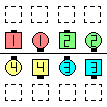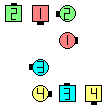From a 4 x 4 Matrix, visualized as 4 adjacent Columns | Lines | Waves.
Split the 4 x 4 Matrix into two sets of adjacent Columns | Lines | Waves
and work in the resulting 2 x 4 Matrix on each side.

| |

| |

| Work with these positions for
Split Phantom Columns | | vor
Split Phantom Columns
Triple Cross | | nach
|
|

| |

| |

| Work with these positions for
Split Phantom Lines | Waves | | vor
Split Phantom Waves
In Roll Circulate | | nach
|
|
Hinweise:
-
If the given call requires you to know the facing direction of a phantom, look at that phantom's
opposite within the Split Phantom Columns | Lines | Waves formation. Hopefully that spot is
occupied by a real dancer, in which case your phantom is facing the opposite direction of that dancer.
This is known as Assume Symmetry. Some callers believe you should always do this; other
callers believe you should never do this (I am of the latter opinion).
-
If the caller says Split Phantom Waves, then you have more information
about the facing direction of the phantoms: they must be in Waves!
-
Imagine there is a brick wall dividing the two halves of the set.
This can prevent you from crossing over into the other half of the set.
-
Shape-changing calls are allowed. Do the given call, keeping track of the phantoms, and breathe
as necessary so that the two resulting formations are adjacent to each other.
-
Historically, Split Phantom Columns | Lines | Waves have also been known as
Phantom Split Columns | Lines | Waves.
|
From a T-Bone starting formation, each dancer individually determines how to split the 4 x 4 formation.

| |

| vor
Split Phantom Waves
In Roll Circulate | | nach
|
|
|
Split Phantom Columns | Lines | Waves is also occasionally used from a 1 x 16.

| Work with these positions for
Split Phantom Lines |
|
Siehe auch